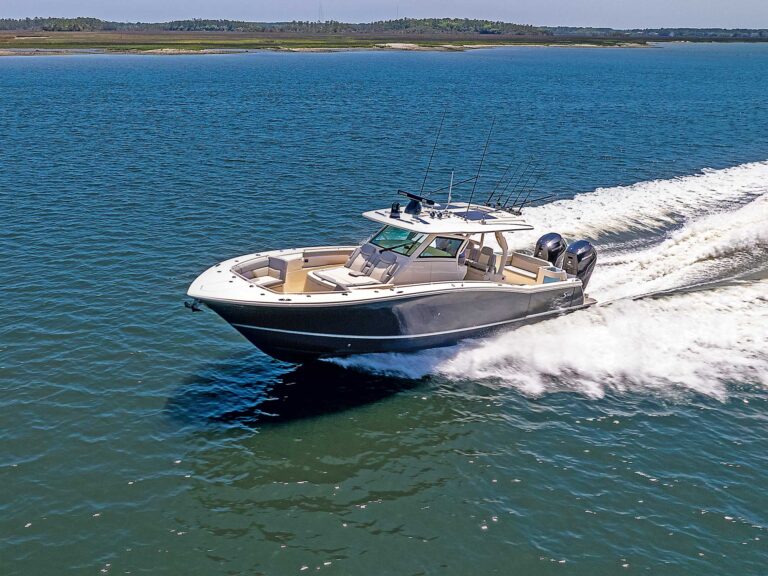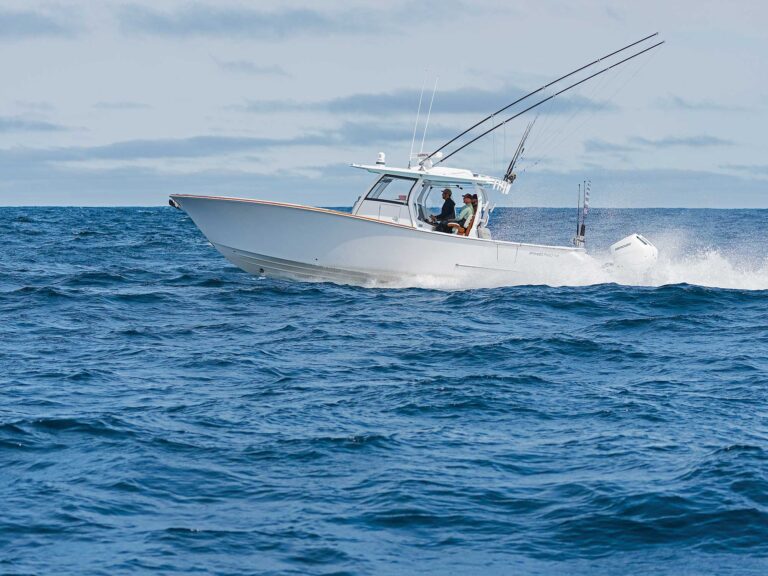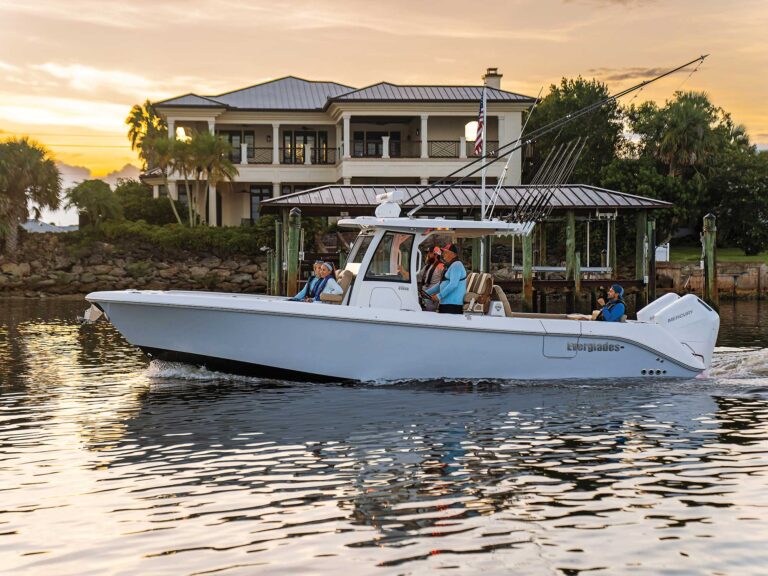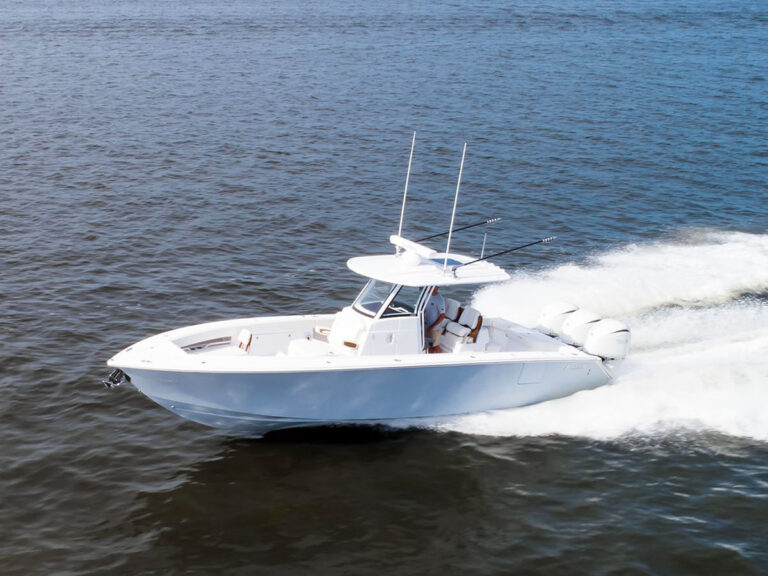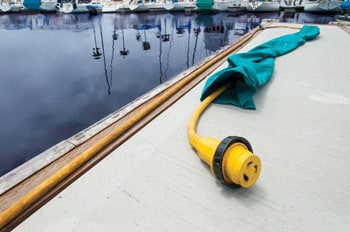
Mike is a marine systems engineer and technical writer for Nordhavn Yachts, an ABYC Master Technician and a longtime boating journalist.
At least eight deaths were attributed to faulty boat and dockside wiring in 2012. Many more fatalities were listed as drowning, though many were likely caused by electric shock drowning (ESD), some revealed as such by subsequent investigation. While ESD remains a persistent threat, heroic efforts are being made to encourage boaters and the industry to help prevent these needless fatalities. Here, through the lens of a boating family’s first-hand account, we explore the danger, causes and cures for this deadly phenomenon.
Young men and women who grow up boating often have a confident, mature presence. Kevin and Sheryl Ritz were eager to give their children that experience, until an August afternoon of boating in 1999 turned deadly. They lost their 8-year-old son, Lucas, who became one of the first fully understood fatalities caused by what’s become known as ESD.
“One minute he was laughing and playing,” Kevin Ritz says. “The next minute he was gone.” In the 14 years since, Ritz has devoted his life to preventing others from knowing his pain. Insidious and silent killer are terms he uses to describe ESD.
“It was a hot summer day,” the story begins as Ritz, now 50, tells of the marina on the freshwater Multnomah Channel of the Willamette River north of Portland, Oregon, where he lived aboard with his wife and three young children, Ian, Lucas and Kyra. Ritz’s own childhood was full of faraway foreign ports and life aboard boats. “We were going to live aboard, teach our kids school aboard and give them that amazing experience,” he says.
When his two boys got in the water on that fateful August day, they were wearing Type II life jackets. They let the current carry them downstream as Sheryl kept watch on the dock — an activity kids and adults had been enjoying for years. As Lucas approached a dock to get out, he let out a gasp and rolled onto his back, apparently unconscious.
Ritz, working on his boat, rushed to the scene. “I checked for a pulse and didn’t find one,” he recalls. “I checked for breathing — Lucas was not breathing. I immediately started CPR. I was encouraged that Lucas’ color was good — I’d seen drowning victims before and their color was always so dull and gray. But I was very disturbed as I looked into his eyes while doing mouth-to-mouth and chest compressions — I kept looking into his eyes and there was nobody home.”
The coroner’s report called it drowning. That didn’t compute for Ritz. “At no time was Lucas’ face in the water,” he says. “He was wearing a life jacket that will keep your face out of the water, even if you’re unconscious.”
The next day, after hearing his older son and wife use words like tingle and numbness to describe how the water felt, Ritz began looking for electricity in the water. He found it. An electrical fault aboard a boat was flowing electricity into the water. The death certificate was changed from drowning to “electrocuted in water while swimming.”
“I’d been around boats my whole life and I’d never, ever heard of such a thing,” Ritz says. “We felt we were being as safe as we possibly could. We were completely ignorant about this.” He wasn’t alone. In his journey to understand what happened to his son, Ritz discovered that most in the boating industry were as unfamiliar with ESD as he was.
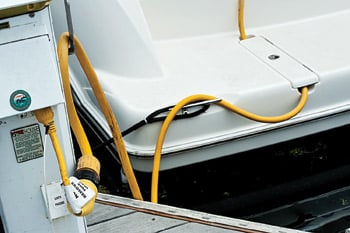
The Problem
Electric shock drowning has become the catchall term that includes in-water electrocution — what happened to Lucas — and drowning that is a result of becoming paralyzed by electricity in the water. There have been more than 100 confirmed cases of ESD, including four over last summer’s July 4th holiday. Due to the difficulty of detection, many drownings caused by ESD are not properly reported or investigated. An autopsy won’t reveal evidence of ESD, so investigators have to rely on eyewitnesses hearing cries for help or accounts of others in the water feeling a tingling sensation. Otherwise, it will be reported as a drowning. Meanwhile the real cause of death — the electricity in the water — goes undetected.
While most ESD fatalities happen around boats at marinas, there have also been cases in water fountains, irrigation ditches, golf course ponds and other bodies of water dating back to the mid ’80s. It’s not uncommon for would-be rescuers to jump in to help and become victims themselves. There have even been cases in which people jumped in to help their dog, which survived and the people perished.
Numerous factors come into play. The amount of electricity in the water; freshwater purity; the size, gender and orientation of the person in the water; the distance from the power source, etc. will influence whether a person is electrocuted, paralyzed or just feels a tingle. Regardless of the outcome, when it comes to a boat plugged into shore power, there are two problems that must be present for electricity to get into the water.
The first is an electrical fault on the boat — a short circuit, a wiring error, a malfunctioning appliance — something that is sending AC electricity away from its intended path. Electricity travels in a circular loop from its source to the load — say, a light bulb — and then back to its source. Hence the term circuit. If a fault disrupts this loop, the electricity seeks another path back to its source.
A proper AC electrical system is designed to handle faults using the green “grounding” wire, which is a backup return path that completes the circuit to safely route the electricity back to the power source on shore. In doing so, a fault or short typically trips a circuit breaker to remove danger. But what happens if this backup path itself is somehow compromised — or even missing? One of these situations is the second necessary element for ESD to occur. Now we have a recipe for disaster because the only path left for electricity is through the water.
The result is a potentially dangerous patch of water that radiates out from the boat’s underwater metals such as the propellers, sterndrive or through-hull fittings. Anyone in this patch of water is in danger of ESD.
ESD remains a freshwater phenomenon. Fresh water is highly resistant to electrical flow, so a person swimming in fresh water becomes the path of least resistance. Seawater’s salt content makes it more than 500 times more conductive than fresh water. This, along with a person’s natural skin/fat resistance, causes almost all the electricity to flow around a swimmer in seawater. Fresh water focuses almost all the electrical flow through the person — and it doesn’t take much electrical flow to kill.
Electrical flow is measured in amps. It takes only one-third (0.33) of an amp to power a 40-watt light bulb. Now consider that a Taser gun can incapacitate a person using only 2 milliamps (mA) — that’s 0.002 amps. It takes only 10 to 22 mA (0.01 to 0.022 amps) to cause paralysis and loss of ability to breathe. At 50 to 65 mA (0.05 to 0.065 amps) fatal heart fibrillation becomes possible, and anything more than 100 mA (0.1 amp) — less than a third of the electricity required to power a 40-watt light bulb — is considered absolutely deadly.

The Solution
Ritz and others studying ESD believe the most effective way to prevent fatalities is to keep people out of the water. One of the foremost authorities on ESD is retired Navy Capt. David Rifkin, who runs a marine safety business and was part of a team commissioned by the U.S. Coast Guard to investigate the causes of ESD. In Rifkin’s view, it’s time for everybody to accept a new way of thinking.
“The culture has always been to go swimming down at the docks,” he says. “Then we started electrifying the docks with lights and shore power — but we still kept swimming. It’s a tough nut to crack, but if the dock has electrical power, don’t swim around it.”
Ritz wants boaters to be part of the solution. “The number one thing boaters can do is pass this information to all their friends,” he says. “All those people who perished last Fourth of July — if any of them knew this was a possibility, I think some of them would not have been in the water.”
No amount of awareness is going to prevent people from falling in the water occasionally. This is where the safety standards of the American Boat and Yacht Council (ABYC) come in.
The standards require an equipment leakage circuit interrupter (ELCI) — similar to ground fault current interrupter (GFCI) outlets required in residential bathrooms and kitchens — to be installed in the shore-power circuit. If an electrical fault develops and 30 mA (0.03 amps) or more try to take the wrong path back ashore (like through the water), the ELCI trips the breaker. These devices cost about $400, and Lucas Ritz and countless others would still be alive today had these devices been in place. Buyers of new boats should confirm shore-power ELCI devices are present.
The recommendation for older boats is to bring them up to current ABYC shore-power standards. Both Ritz and Rifkin are instructors for ABYC, and they have trained countless marine electrical technicians. These technicians should be called upon to inspect older boats and make the necessary fixes (a list of certified electrical technicians is available at abycinc.org). There have been many ESD fatalities caused by boaters and untrained workers making improper wiring modifications on boats.
There is also plenty that marina operators can do. Some are beginning to post no-swimming signs and install dockside ground fault protection (GFP) devices — especially in areas hard hit by ESD, like Lake of the Ozarks. Some also provide monitoring and require boats leaking electricity to fix the problem or leave. The National Fire Protection Association (NFPA) and National Electric Code (NEC) offer guidance to prevent ESD at marinas, but awareness seems low. “Most marina operators don’t know these guidelines exist,” Rifkin says. “And the few who do know — most of them don’t follow the guidelines due to cost.”
Still, Ritz sees marinas as a battle worth fighting. “Ultimately, protection needs to be at the marina,” he says. “The European, Australian and New Zealand standards require ground fault protection on a marina’s main feeders and power pedestals. They’ve had zero ESD fatalities in the nearly 30 years they’ve had this in place.”
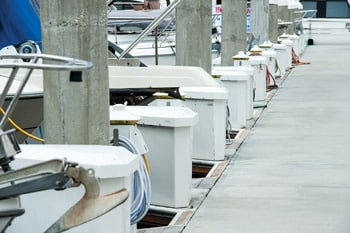
The Fight Continues
Ritz currently lives ashore with his family in Scappoose, Oregon, a stone’s throw from where his young son’s life was taken in 1999. His latest effort has been to create the Electric Shock Drowning Prevention Association (electricshockdrowning.org), which is intended to bring professionals together to help marinas get on board with ESD prevention.
“I don’t think there is a single individual who has done more to help the cause of ESD awareness and prevention than Kevin,” Rifkin says. “I guarantee lives have been saved through his efforts.”
When he’s not out in the trenches, Ritz is busy offering a shoulder to other unfortunates who have lost a loved one to ESD. “It’s not a club you want to become a member of,” he says. “But if you do it’s nice to have others around who know what you’re going through.”
For now, Ritz is guardedly optimistic that his club will stop getting bigger. “These efforts are beginning to pay off,” he says, “but we’ll really know they’re working when we start going through summers and nobody dies.”
Suggested Reading
Drowning Doesn’t Look Like Drowning
Electric Shock Drowning Resources
Regularly Updated List of ESD Victims
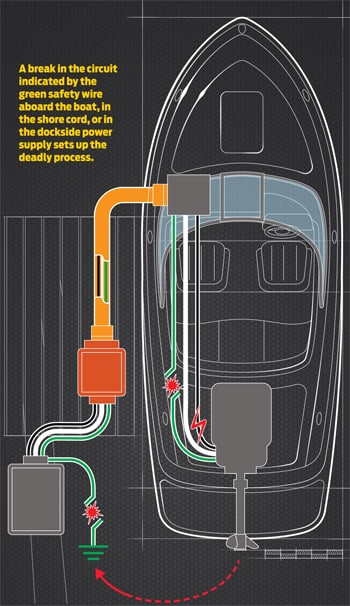
How It Happens
The specifics of having any given boat plugged into shore power are innumerable, but in any case two things must occur for AC electrical current to flow through the water and put swimmers, divers servicing hulls, and those who fall overboard at risk. The first is an electrical fault aboard the boat. This could be a short circuit caused by deteriorated wire insulation or by a failure of the wiring within a device or appliance in use aboard.
The second is a break in the green “ground” safety wire of the boat, shore cord or dockside power source. This green wire is designed to carry fault current back to its source, and in the event of a short in a wire, or a fault within an electrical device, to trip the breaker. But if the green wire is broken, missing, corroded or improperly wired, the safety feature is gone. Fault current then seeks another path back to its source ashore, often through bilge water, metal fittings or drives, and finally through the marina water.
Test Your Dock
Industry pros liken plugging a boat into shore power to tossing a hair dryer in a bathtub. This is why ABYC devotes pages of guidance on how to properly wire a boat. While there are similarities between household wiring and boat wiring, there are a number of key differences that can mean life or death. An electrician who is not aware of these differences could create an ESD hazard by wiring a boat like he would a house. When it comes to your boat, it’s best to invest in a trained marine electrical technician for wiring, repairs and modifications.
That said, you can perform a check of your boat’s electrical connection by using a clamp meter like the Blue Sea Systems mini clamp multimeter ($150, westmarine.com), which resolves AC milliamps. Clamp it around the shore cord. If all is well, you will get a “ zero” reading. If you get any reading other than zero, that is an indication that current is leaking from somewhere in the system. It could be your boat, another boat or the marina’s wiring. Unplug the boat. It’s time to call in the pros.
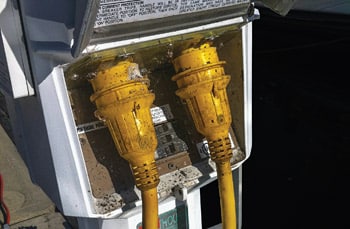
Protective Measures
A quick look at shore-power devices and wiring guidance available to protect you, your crew and your boat while plugged in at the dock.
BUILD A TESTER YOU CAN USE TO CHECK FOR LEAKING CURRENT
Galvanic Isolator
Galvanic isolators are designed to prevent your boat from suffering from, or contributing to, galvanic corrosion while plugged into shore power by blocking low-level DC current caused by galvanic action. A “fail-safe” galvanic isolator is by far the best choice because ABYC requires that, if a fail-safe isolator malfunctions, it must fail in the closed position — that way the green safety wire is still available to protect the boat from AC short circuits.
Reverse Polarity Indicator
If the neutral wire becomes hot, you lose protection from circuit breakers that are installed in the hot wire. Also, reverse polarity can electrify a boat’s underwater metals. A shore-power plug’s shape prevents it from being plugged in the wrong way but doesn’t prevent improper wiring. ABYC requires a reverse polarity indicator on boats that don’t have an isolation transformer and that place circuit breakers only in the hot wire of branch circuits.
Isolation Transformer
An isolation transformer transfers electricity from the shore to the boat without the shore wires physically touching the boat’s wires, turning your boat into its own power source. If there is a fault, the current no longer seeks a path through the water back to shore. ABYC allows isolation transformers installed within 10 feet of a shore-power inlet in lieu of the equipment leakage circuit interrupter (ELCI) devices now required by ABYC.





